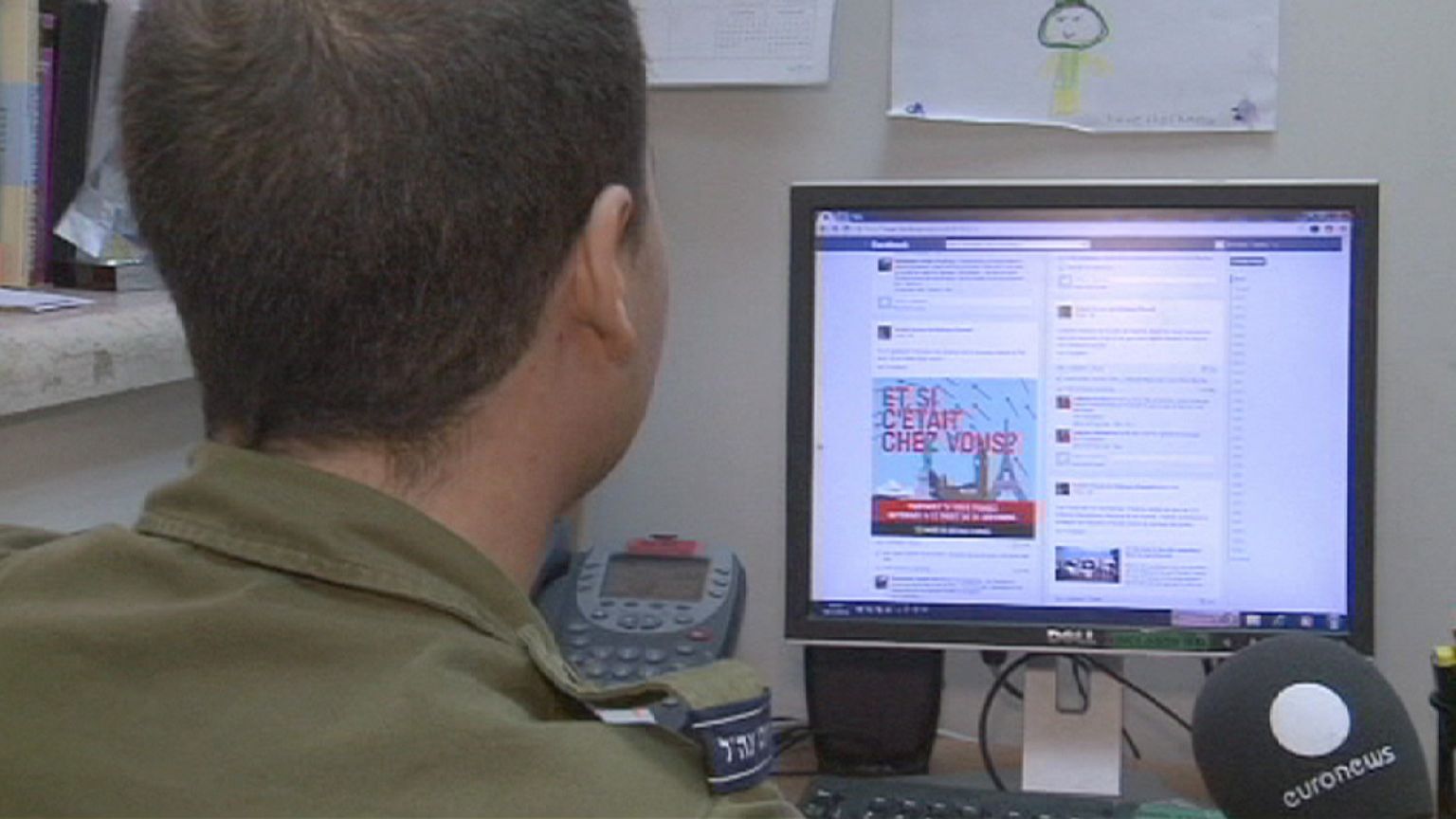Military communication isn’t what it used to be. The Israeli Army is taking a whole new approach.
It is using Internet social networks in an effort to lighten negative views about the security struggle with Gaza.
In a modern office building in West Jerusalem, they take a softer online approach than on the front line. There, the Israeli Defence Force means armour, infantry and gun barrels. Here, the weapon is user-friendly consumer information. Meet the new media warriors.
In the deadly Gaza context, military spokesperson Avital Leibovich works to defuse global recriminations.
She said: “The goal of this is to actually try and reach audiences all over the world, audiences that maybe don’t get their information messaging from the mainstream media. We would like to reach out to those audiences and to influence them as much as we can by supplying them information and content, visual and other.”
Luis Carballo, euronews’ Mideast correspondent
 “Operation Pillar of Defence can be followed almost in real time through the IDF’s Twitter and Facebook accounts. It’s a lot of raw data but not only that: articles claiming to show the ‘terror’ of Hamas and how the Palestinian group has made of Gaza a branch of Iranian policy, can also be found there. Information that cannot be confirmed independently. The IDF gives it ready-to-use and in an attractive form. The rigid and out-dated military communiqués are part of the past. The information comes in the shape of Youtube videos, infographies showing the different floors of a building in Gaza, where the last floor can be occupied by a press center and the basement used to storage Hamas missiles, or in the form of a leaflet launched by air to the civilians in Gaza, or in the shape of a poster showing Paris, London or New York under a rain of Qassam rockets and asking: ‘what if in instead of Tel Aviv this happened to your city?’ The purpose of all this is to get the public opinion informed. But informed in the way the IDF would like it to be.”
“Operation Pillar of Defence can be followed almost in real time through the IDF’s Twitter and Facebook accounts. It’s a lot of raw data but not only that: articles claiming to show the ‘terror’ of Hamas and how the Palestinian group has made of Gaza a branch of Iranian policy, can also be found there. Information that cannot be confirmed independently. The IDF gives it ready-to-use and in an attractive form. The rigid and out-dated military communiqués are part of the past. The information comes in the shape of Youtube videos, infographies showing the different floors of a building in Gaza, where the last floor can be occupied by a press center and the basement used to storage Hamas missiles, or in the form of a leaflet launched by air to the civilians in Gaza, or in the shape of a poster showing Paris, London or New York under a rain of Qassam rockets and asking: ‘what if in instead of Tel Aviv this happened to your city?’ The purpose of all this is to get the public opinion informed. But informed in the way the IDF would like it to be.”
The army says it already has more than 300 young recruits helping to transform messages that may originate with three-star generals, strategists and politicians. It began setting up its new media department in 2008. As well as the cell in Jerusalem there is one in Tel Aviv.
Leibovich said: “There is a difference between a military organisation and social networks. Why? A military is more closed, the language is more harsh, it’s different. The social network is exactly the opposite. It calls for interactions; it’s open, it’s a lot more emotional. But the big advantage that we have is that we have people like Topaz and his friends, who are 18-year-olds and were born to this kind of reality. This is why they can be so creative and we can benefit from their creativity.”
Topaz told us: “Everything that comes out is put in English, French and Spanish at the same time. This is an example of the leaflets that we bring to the civilians in Gaza. This is also an example of what we do. I’m showing you of course the French website as you can see, the French Facebook page.”
How long is #15seconds? That's all some residents of southern #Israel have before the rocket hits. youtube.com/watch?v=gsm-mE…
— IDF (@IDFSpokesperson) Novembre 19, 2012
Facebook, an interface for hundreds of millions of users around the world, and YouTube… If everyone else uses these, what’s to stop the Israeli government?
The IDF twitter account has more than 200,000 followers and is checked daily by foreign journalists covering this crisis.
Users must judge what they see, read and hear for themselves, of course, but the new media warriors are determined to leave no webpage unturned in their effort to present their version of events.
Luis Carballo, our correspondent in Israel, reporting from Jerusalem, said: “These walls have witnessed battles for centuries, but while the confrontation today between Israel and Hamas is being waged with the same weapons as always, but there is also a new, very different one: the Internet. In this version of war, Israel wants to reverse reasoning which says it usually wins on the field of battle but as often as not loses the war of communication.”
The Israeli military and political authorities want to avoid harmful press by being pro-active in presenting their rationale for their actions swiftly.
New media expert Yuval Dror described this innovative experiment.
Dror said: “Social media has two messages: the first one is all about conversation. It’s not a one-way street, it’s a two-way conversation, and the IDF want to take part in it. The second message is they’re cutting out the middle-man [traditional journalist or media outlet]. They want to speak directly to the audience, because they believe that the middle-man, sometimes, does not represent the IDF story as it should.”
Dror also addressed a question of the IDF’s online dispersion of information using media generally considered a domain of lighter content. Is it appropriate?
Dror said: “I can understand Twitter, I can understand Facebook… but Tumblr? and Flickr? Maybe it’s a little bit in teenager style, I mean after all, this is a war, there are casualties, there is a lot of damage, and maybe they are taking it a little bit too trivialised, they are making it an everyday event. And a lot of criticism is about this point: maybe social media is not the right platform for this kind of an event.”
120+ trucks of supplies from #Israel are waiting at #Gaza border crossing. #Hamas is firing rockets at the crossing. Trucks can't enter now.
— IDF (@IDFSpokesperson) Novembre 20, 2012
Israel is constantly and accutely aware of other countries’ scrutiny. The authorities hope to lessen the impact on public opinion by explaining certain decisions.
Dror said: “We haven’t seen an army using social media with such an intensity before, and I don’t think it’s the last one, because social media is the new media, is the new thing. The audience is there, we know that millions, a billion people are on Facebook, you want to communicate (to) this audience where it’s sitting. First, it’s unprecedented, and second, there will be followers after the IDF.”
The strategy is far from guaranteed to be successful. How will sophisticated communication weigh in the balance against video of Palestinian civilians being pulled out of destroyed buildings?
Dror said: “Let’s take your example, there was a building (hit by a missile/rocket), a lot of people got killed. One side of the story is, look how many kids died. The other side of the story, maybe, I don’t know if that is the case, but maybe there was a terrorist inside this building, and this terrorist hid in a place with civilians because he knew that the IDF would not search for him. So this is the same story, but two sides of it, and in the past the IDF was accused of not telling its story, of not telling the entire story. And this time, it doesn’t “take prisoners”, quote, unquote, it (the army) tells the story straight to the audience. Will it help? I don’t know, but it’s a nice effort.”














